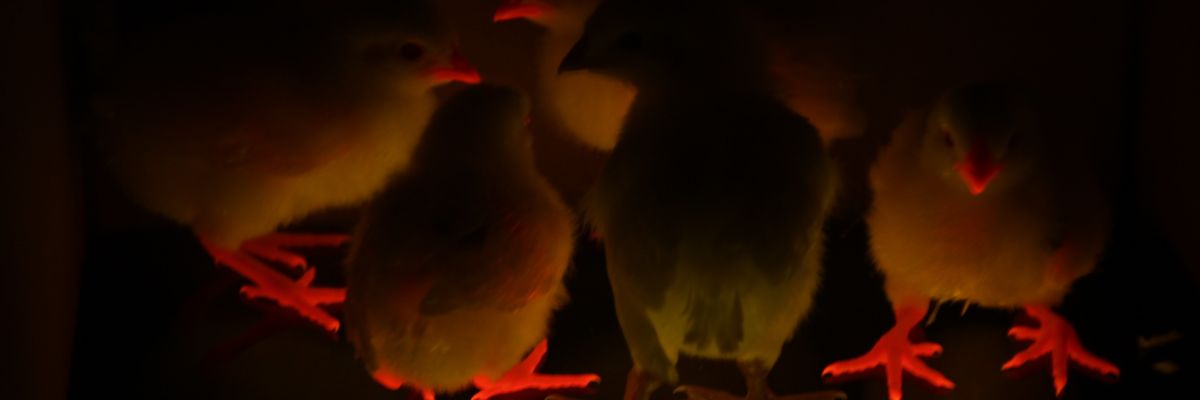
Robin, the first chicken that glows in the dark
Robin, the first chicken that glows in the dark
Mon Nov 27 15:41:10 CET 2017
The first cloned sheep was named Dolly. Rudík, on the other hand, is the first red florescent chicken. Jiří Hejnar from the Institute of Molecular Genetics of the CAS and Pavel Trefil from the company BIOPHARM have come up with pioneering experiments on genetic modifications in birds. They are able to put genes into the chick to produce or correct the required proteins, such as those that viruses and parasites use. The research can contribute not only to a new breeding method but also to the use of hens as a living bioreactor.
“We use techniques that are commonplace in genetic modifications of fish, mice and livestock. This had so far not been possible in birds, and few have ventured into such research. Our method dramatically increases effectiveness and shortens the whole procedure,” says Jiří Hejnar.
Genetic modifications in mammals
Genetic manipulations in the sense of adding a foreign gene into the genetic furnishings of an organism or, on the contrary, removing a gene are common methods in laboratory animals. In the case of livestock, they can alter the characteristics and performance with a speed and specificity that classical breeding cannot achieve.
In mammals, embryonic stem cells isolated from early embryos are used, which can be cultivated in vitro and into which it is possible to introduce the relevant changes in the DNA. This method is absolutely routine in laboratory mice and the Nobel Prize for Physiology and Medicine was awarded already ten years ago for the principle of the removal of a gene (Capecchi-Evans-Smithies).
What good are chickens that glow in the dark?
When the teacher at school asked asked Jiří Hejnar’s daughter what her dad did, she found out that he did glowing chickens. “To the question of what they are good for, my daughter answered that because the homeless could find them better in dustbins,” Jiří Hejnar remembers with a smile.
The truth is that, for easy detection, he added the red fluorescence protein mCherry to the genome of chickens. It is clear evidence that genetically engineered cells that have entered the testicle of the cock will then also appear in the chickens born. Thanks to this work, there is a chance that scientifically and practically significant genetic modifications in poultry will soon reach the level usual in mammals.
The path was thorny
If they work with embryonic stem cells in mammals, the situation in birds is much more complicated. Early embryos are almost inaccessible, a freshly laid egg already contains an embryo with several tens of thousands of cells. Therefore, the interest was focussed on so-called primordial germ cells, the early forerunners of the developmental series of the sperm or egg. These cells are present in very small amounts in the blood of the bird embryos for a few days after the egg is laid. From there, they can be isolated and treated as embryonic stem cells in mammals. The problem is their return to the bird’s embryo. They can be reintroduced into the bloodstream, but it is technically difficult. In addition, these genetically modified cells compete with the recipient’s own cells. As a result, there is only a tiny representation of genetically modified cells among the adult sexual cells, and transmission to the next generation is rare.
Moreover, the entire method is very financially demanding and has only been successful twice in the whole world.
In the resolution of this problem, Czech and German scientists achieved fundamental technical advancement. They transplanted genetically modified primordial germ cells not into the bloodstream of chicken embryos but into the testicles of adult roosters, who were sterilized in advance by radiation, by which competition with their own sperm was eliminated. It somewhat surprisingly showed that the transplanted cells in the environment of adult testicles can undergo all the stages of their development up to functional sperm, which can then assure the transfer of the genetic modification to their offspring.
Hens as a bioreactor
In the future, we can also encounter living bioreactors. It is possible to place the human genome into the hereditary information of the domesticated chicken and the animal’s organism can make a healing human protein from it. This protein secreted into egg white can then become the basis for producing a whole range of drugs.
Prepared by: Vlaďka Coufalová, Department of Media Communication of the Head Office of the CAS
Photo: archive of the Institute of Molecular Genetics of the CAS
